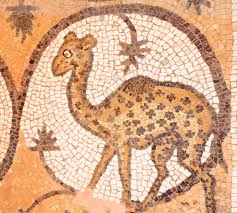|
Painting was the most common technique used for monumental decoration in Byzantium, the Balkans, the Caucasus and Russia.
Much less expensive than mosaic and quicker to execute, painting offered not only an accessible alternative but also a medium with different properties, notably the fluid compositions. Painted decoration usually covered all surfaces, even imitating marble or fabric on the lower sections. The painting was executed on one or more coats of plaster, progressively applied to the walls.

The painters tried to make the edges of the support correspond to those of the compositions, but sometimes there were perceptible lines where they joined. After the production of a preliminary drawing with a brush or charcoal, the backgrounds and flat surfaces were painted first, from top to bottom.
The churches of the region of Troodos are a well conserved example of rural religious architecture during the Byzantine period. The refinement of their decor provides a contrast with their simplicity of structure. The latest post-Byzantine painters alone, with their 'rustic' style, are at times in harmony with this vernacular architecture.

By the tenth century the practice of decorating the walls of the churches had become more widespread. The most beautiful church in the empire, Hagia Sophia, is still standing today. It was built in Constantinople under the rule of Justinian. A form of art the Byzantines excelled in were mosaics. If an artist was talented, they could capture every distinct skin tone in their work.
The Church of the Transfiguration of the Saviour (Ayia Sotira) in Palaichori belongs to the architectural type of the steep-pitched wooden roof with flat hooked tiles. This type of roofing over a Byzantine church is not found elsewhere, making the wooden-roofed churches of Cyprus a unique group example of religious architecture. The church is a type of construction that is characteristic of the mountainous region of Troodos. It is particularly notable for its very rich wall-paintings, dating back to the 16th century.
The Byzantine religious architecture was distinctive for the absence of decoration with statues which was forbidden. The inner walls were decorated with splendid mosaics, mostly of colored glass. The mosaics predominantly decorated the apses, ceilings and walls above the columns. However, sometimes colorful mosaics covered almost the entire church. The best example is the St Mark’s Basilica in Venice, Italy, built in the Byzantine style and covered with more than 8,000 square meters of mosaics.
Byzantine art, however, though not always to the taste of the West, was profoundly religious and in many respects quite original, especially its mosaics and icons (when they were allowed); the craftsmanship of Constantinople was often superb and quite beyond comparison with anything in the West until at least the High Middle Ages.
Several ancient pavement mosaics, bearing inscriptions in Armenian, have come to light in Jerusalem; they are decorated with floral designs, except one which has a representation of Orpheus, the pagan theme frequently used by the artists of the Early Christian period.
|

![]()

